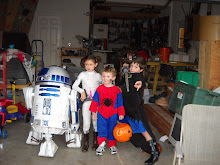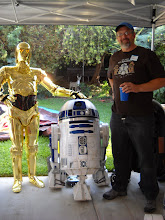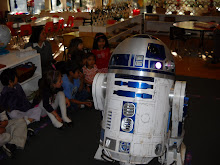
Once those were dry, I squeezed the mounted legs together on the frame with a clamp so that they were sitting were they should on the body, then I drilled a hole down through the two pipes (one inside the other) on the inside. I don't know much about drilling or machining metal, and I am sure I wrecked my bit. I used some motor oil to lubricate it up and keep it a bit cooler. Once I had a hole all the way through, I could insert a little king pin I rumaged up at Home Depot through. This will hold the two legs onto the body and ideally it will hold them locked into the same plane of movement. R2 doesn't need independent leg movement on the big legs. But even after all this trouble, I still had some play in the two legs. The hole I had drilled was a tiny bit too big, I think. I'll think about what to do next. Another pin, as Senna suggests would probably do the trick.
Next, I took the plunge and carefully trimmed off the extra length I had left on the center leg on the bandsaw. With some careful sanding on the belt sander, I got the top all flush and flat. Then I fashioned a mounting plate for it from 3/4" plywood that would fit down into the square hole in the bottom of the frame. I put rabbet edges on the plate to make it fit, and I routed out a space for the leg to mount in. This whole assembly will fit down into the frame and be visible from underneath.

I've tried a lot of different spray paints on this project trying to get the right results. I put a coat of Rustoleum primer on this plate, then a couple coats of Rustoleum satin white No Rust paint and the results seem to be better than anything else I've tried. I'm always impatient and put too much paint on and get drips. It seems to help to put on more lighter coats, and to get the piece to lay down flat as much as possible.







No comments:
Post a Comment